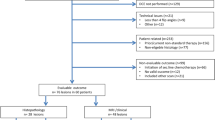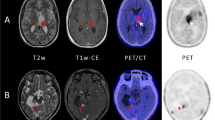Abstract
Purpose
The aim of this study was to evaluate the clinical value of the use of O-(2-[18F]fluoroethyl)-l-tyrosine (FET) positron emission tomography (PET)/computed tomography (CT) in patients of a neurological clinic for evaluation of brain lesions newly diagnosed by magnetic resonance imaging (MRI).
Methods
We evaluated 88 patients (44 women and 44 men) with a mean age of 50 ± 19 years who were sent consecutively for evaluation of an intracerebral mass or lesion observed by MRI from 2006 to 2008. Hospitalization was necessary due to neurological clinical symptoms. Images were obtained by PET/CT 30 min after i.v. injection of 185 MBq FET. Coregistration with MRI was done by HERMES workstation.
Results
FET uptake above the cortical level was observed in 60 patients. Neurosurgery was performed in 60 patients (51 with FET-positive imaging); 36 high-grade and 19 low-grade tumours were verified histologically. The sensitivity of FET PET for high-grade tumours (WHO III–IV) was 94% in this setting. Among the low-grade brain tumours (WHO I–II) 13 of 19 were FET positive, which indicates a sensitivity of 68%. Five of ten (50%) astrocytomas I and II could not be visualized by FET. Histological data were not provided for 28 of 88 patients, so the diagnostic approach is based upon longitudinal observation. Radiological and/or clinical control was done at a median of 7 months later. Three patients (all FET positive) died a few months after the examination because of rapid progression of the malignant brain tumour. A malignant entity could be excluded in the other 25 patients. Considering the whole cohort of 88 patients, 43 patients with malignant tumour could be identified, including high-grade glioma, intracerebral lymphoma (n = 1) and metastasis (n = 3). The sensitivity of FET PET for detecting a malignant tumour entity was 93%. We observed two false-positive cases with postischaemic lesions. Remarkably, the two patients with cerebral gliomatosis were false-negative on FET PET imaging. The negative predictive value for a malignant entity was calculated to be 89%.
Conclusion
Our results indicate a high sensitivity of FET PET for detecting high-grade glioma in patients with neurological symptoms and recently observed brain lesions by MRI. In the setting of evaluating new brain lesions of unknown significance via FET PET a negative image can encourage a wait and see strategy—of course in accordance with the clinical picture and morphological imaging.




Similar content being viewed by others
References
Del Sole A, Moncayo R, Tafuni G, Lucignani G. Position of nuclear medicine techniques in the diagnostic work-up of brain tumors. Q J Nucl Med Mol Imaging 2004;48:76–81.
Pauleit D, Floeth F, Tellmann L, Hamacher K, Hautzel H, Müller HW, et al. Comparison of O-(2-18F-fluoroethyl)-L-tyrosine PET and 3-123I-iodo-alpha-methyl-L-tyrosine SPECT in brain tumors. J Nucl Med 2004;45:374–81.
Jager PL, Vaalburg W, Pruim J, de Vries EG, Langen KJ, Piers DA. Radiolabeled amino acids: basic aspects and clinical applications in oncology. J Nucl Med 2001;42:432–45.
Langen KJ, Hamacher K, Weckesser M, Floeth F, Stoffels G, Bauer D, et al. O-(2-[18F]fluoroethyl)-L-tyrosine: uptake mechanisms and clinical applications. Nucl Med Biol 2006;33:287–94.
Heiss P, Mayer S, Herz M, Wester HJ, Schwaiger M, Senekowitsch-Schmidtke R. Investigation of transport mechanism and uptake kinetics of O-(2-[18F]fluoroethyl)-L-tyrosine in vitro and in vivo. J Nucl Med 1999;40:1367–73.
Weckesser M, Langen KJ, Rickert CH, Kloska S, Straeter R, Hamacher K, et al. O-(2-[18F]fluorethyl)-L-tyrosine PET in the clinical evaluation of primary brain tumours. Eur J Nucl Med Mol Imaging 2005;32:422–9.
Pöpperl G, Kreth FW, Herms J, Koch W, Mehrkens JH, Gildehaus FJ, et al. Analysis of 18F-FET PET for grading of recurrent gliomas: is evaluation of uptake kinetics superior to standard methods? J Nucl Med 2006;47:393–403.
Pöpperl G, Goldbrunner R, Gildehaus FJ, Kreth FW, Tanner P, Holtmannspötter M, et al. O-(2-[18F]fluoroethyl)-L-tyrosine PET for monitoring the effects of convection-enhanced delivery of paclitaxel in patients with recurrent glioblastoma. Eur J Nucl Med Mol Imaging 2005;32:1018–25.
Floeth FW, Pauleit D, Sabel M, Stoffels G, Reifenberger G, Riemenschneider MJ, et al. Prognostic value of O-(2-18F-fluoroethyl)-L-tyrosine PET and MRI in low-grade glioma. J Nucl Med 2007;48:519–27.
Weber DC, Zilli T, Buchegger F, Casanova N, Haller G, Rouzaud M, et al. [(18)F]Fluoroethyltyrosine-positron emission tomography-guided radiotherapy for high-grade glioma. Radiat Oncol 2008;3:44.
Vees H, Senthamizhchelvan S, Miralbell R, Weber DC, Ratib O, Zaidi H. Assessment of various strategies for 18F-FET PET-guided delineation of target volumes in high-grade glioma patients. Eur J Nucl Med Mol Imaging 2009;36:182–93.
Floeth FW, Pauleit D, Sabel M, Reifenberger G, Stoffels G, Stummer W, et al. 18F-FET PET differentiation of ring-enhancing brain lesions. J Nucl Med 2006;47:776–82.
Floeth FW, Sabel M, Stoffels G, Pauleit D, Hamacher K, Steiger HJ, et al. Prognostic value of 18F-fluoroethyl-L-tyrosine PET and MRI in small nonspecific incidental brain lesions. J Nucl Med 2008;49:730–7.
Pauleit D, Floeth F, Hamacher K, Riemenschneider MJ, Reifenberger G, Müller HW, et al. O-(2-[18F]fluoroethyl)-L-tyrosine PET combined with MRI improves the diagnostic assessment of cerebral gliomas. Brain 2005;128:678–87.
Weber WA, Wester HJ, Grosu AL, Herz M, Dzewas B, Feldmann HJ, et al. O-(2-[18F]fluoroethyl)-L-tyrosine and L-[methyl-11C]methionine uptake in brain tumours: initial results of a comparative study. Eur J Nucl Med 2000;27:542–9.
Rau FC, Weber WA, Wester HJ, Herz M, Becker I, Krüger A, et al. O-(2-[(18)F]Fluoroethyl)-L-tyrosine (FET): a tracer for differentiation of tumour from inflammation in murine lymph nodes. Eur J Nucl Med Mol Imaging 2002;29:1039–46.
Stadlbauer A, Pölking E, Prante O, Nimsky C, Buchfelder M, Kuwert T, et al. Detection of tumour invasion into the pyramidal tract in glioma patients with sensorimotor deficits by correlation of (18)F-fluoroethyl-L:-tyrosine PET and magnetic resonance diffusion tensor imaging. Acta Neurochir (Wien) 2009;151:1061–9.
Stadlbauer A, Prante O, Nimsky C, Salomonowitz E, Buchfelder M, Kuwert T, et al. Metabolic imaging of cerebral gliomas: spatial correlation of changes in O-(2-18F-fluoroethyl)-L-tyrosine PET and proton magnetic resonance spectroscopic imaging. J Nucl Med 2008;49:721–9.
Sadeghi N, Salmon I, Decaestecker C, Levivier M, Metens T, Wikler D, et al. Stereotactic comparison among cerebral blood volume, methionine uptake, and histopathology in brain glioma. AJNR Am J Neuroradiol 2007;28:455–61.
Pötzi C, Becherer A, Marosi C, Karanikas G, Szabo M, Dudczak R, et al. [11C] methionine and [18F] fluorodeoxyglucose PET in the follow-up of glioblastoma multiforme. J Neurooncol 2007;84:305–14.
Acknowledgements
The authors are grateful to Sieglinde Prechtl and her team for cooperation and advise on technical matters, to Manuela Pühringer for invaluable help on data acquisition and to Megan Bittermann for helpful discussion of the manuscript.
Author information
Authors and Affiliations
Corresponding author
Rights and permissions
About this article
Cite this article
Pichler, R., Dunzinger, A., Wurm, G. et al. Is there a place for FET PET in the initial evaluation of brain lesions with unknown significance?. Eur J Nucl Med Mol Imaging 37, 1521–1528 (2010). https://doi.org/10.1007/s00259-010-1457-6
Received:
Accepted:
Published:
Issue Date:
DOI: https://doi.org/10.1007/s00259-010-1457-6




